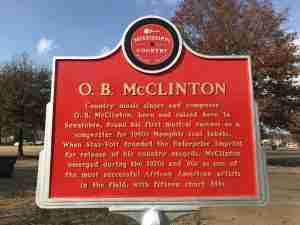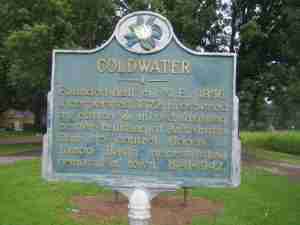Tate County’s Courthouse

The cornerstone for the Tate County Courthouse was laid in June 1875 with an extravagant celebration. Two trainloads of visitors from Memphis joined local citizens from throughout the county for a celebration that included a large parade down Ward Street led by the Temperance Ladies.
Tate County’s unique Italianate courthouse was constructed for $19,800. Additions were made to the courthouse in 1904 and again in 1975. The new courthouse annex was completed in the summer of 1999. During the most recent renovation, the courthouse’s exterior brick, which had been locally made, could not be returned to its original unpainted state because of its porous nature. A paint color was carefully chosen to echo the color of the natural brick, returning the Tate County Courthouse to look as it did when it was first built in 1875. The cost of the new annex and renovations to the original courthouse was $3,152, 900.
During the renovation, the Senatobia Main Street placed a time capsule under the new concrete sidewalk leading to the front door. A commemorative stone was laid to locate the capsule with an inscription which reads, “Time Capsule, Tate County, 1873-1998, Open 2098”. Mementos placed in the capsule included a 125th commemorative anniversary edition of the local newspaper The Democrat, a Bible, a Tate County phone book, a 1998 one-dollar bill and a copy of the book The History of Tate County.
The Tate County Courthouse is home to the Heritage Museum Foundation of Tate County. The museum’s professionally designed display cases feature exhibits of the county’s history, including education, military service, pioneer life, cultural life.
The Tate County Courthouse was added to the National Register of Historic Places in 1994. In 2002, it was awarded the Mississippi Heritage Trust award for excellence. In the summer of 2010, the James Gilliam Chapter, MSDAR, recognized the significance of the historic courthouse with an historic marker.
The Tate County Courthouse may be experienced by self-guided tours, Monday –Friday, 8:00-5:00. Museum exhibits are displayed in various areas throughout the courthouse. And the historic court rooms may be seen when court is not in session.


The History of Senatobia, Mississippi
On April 13, 1834 early settler James Peters purchased two sections of land from the Chickasaw Nation for the sum of $1.25 per acre. The land purchased later became the town of Senatobia. The name Senatobia was derived from the Indian word Senatohoba, which means “White Sycamore” and is a symbol of “rest for the weary.” Charles Meriwether named Senatobia.
Senatobia was originally a rest stop on the trail leading to Hot Springs, Ark. According to legend, the Indians discovered the curative powers of the hot springs and periodically made long trips to Arkansas, stopping to rest in the area that became Senatobia. After the Tennessee and Mississippi Railroad came through in 1856, Senatobia became a railroad station. New commerce came with the railroad and Senatobia saw immediate growth.
Senatobia, the county seat for Tate County, received its charter as a municipality in 1860, thirteen years prior to the creation of Tate County and just one year before the beginning of the Civil War. During the course of the Civil War, Senatobia’s business section was burned twice by Federal Troops.
The 1880 census accounted for over fifty active businesses, a newly established newspaper and several physicians in Senatobia.




Notable Dates in Senatobia History

1860 Senatobia received its charter in 1860.
1874 Many wooden buildings on Main and Front Streets were destroyed by fire.
1875 The cornerstone of the Tate County Courthouse, located in downtown Senatobia, was laid on June 24.
1878 The yellow fever epidemic struck Senatobia.
1880 The newspaper, Tate County Record was first published, later becoming The Democrat.
1881 Senatobia had two gristmills and cotton gins, each in first class running order. Single railroad fare to Memphis was $1.55.
1882 The Senatobia town charter was misplaced. Anyone knowing of its whereabouts was asked to report the same to the mayor or aldermen. The town treasury was reported as being exhausted but out of debt.
1885 N.M. Ward of Senatobia advertised the sixteen-room Greely Hotel for sale. The hotel was reported to be located on the south end of Front Street.
1890 Grove’s Tasteless Chill Tonic, “a pleasant to the taste lemon syrup,” was sold by Senatobia merchants J.W. Hill & Son and by V.P. Still & Co.
1891 In October of this year, a group of 172 Confederate veterans held a reunion in Senatobia.
1892 C.C. Perkins & Co. advertised gingham dresses from 6 1/2 cents up to $1.00. “The cash goes further at C.C. Perkins & Co.”
1897 A new water system was installed replacing wells and cisterns formerly used. A power generating plant was installed in a building on North Ward Street. Lights were turned on from 5 p.m.-10 p.m. and again from 5 a.m.-8 a.m.
1898 Senatobia received its first telephone system; a one-year subscription to the Senatobia Democrat cost $1.25.
1900 Senatobia’s population was 1,200. Senatobia Bank, Tate County’s longest continuously operated and locally owned bank, opened on April 1, 1900. The bank became Sycamore Bank in 2005.
1901 A smallpox epidemic struck Senatobia.
1903 A. L. McCormick built an Opera House on Front Street. The Opera House presented stage shows, minstrels and served as a community meeting place. Later, four-reel motion pictures were shown here.
1910 A group of Senatobia citizens asked the Mayor and Board of Aldermen to pass ordinances restricting the use of automobiles on the streets in town. Automobiles were said to be a source of danger and they frightened horses.
1912 Ice was sold from a new icehouse, which was located in an insulated warehouse on the railroad tracks in Senatobia.
1914 Senatobia’s first concrete sidewalks were built.
1915 The Tate County Agricultural High School, which later became Northwest Community College, was opened in Senatobia on Sept. 15, 1915.
1916 Peoples Bank, Senatobia’s second longest continuously operated bank, opened for business; it later become First Tennessee Bank.
1917 Senatobia’s first gas pump was installed on the southwest corner of Main and Front Streets.
1919 All vehicles in Senatobia were required to have two lights on the front and one on the rear. The speed limit was 12 miles per hour.
1920 Senatobia’s first sewer system was completed.
1926 Senatobia had 241 customers serviced by electricity.
1927 Senatobia streets were paved and the Tate County Agricultural High School expanded to include a junior college.
1928 Northwest Junior College gained accreditation; the Gloria Theatre opened on Center Street, charging 10 cents and 25 cents for admission.
1930 Senatobia had a population of 1,264.
1932 Senatobia Bank and Peoples Bank kept their doors open during the great depression while many others closed permanently.
1936 Highway 51 was paved.
1938 A new Senatobia high school was completed.
1939 Senatobia extended its city limits, almost doubling its population.
1941 Dial telephone service was installed.
1949 Senatobia’s first traffic light was installed at Hwy. 51 and Main Street costing $400.
1950 Senatobia’s population was 2,108 and the Senatobia Public Library opened.
1954 Senatobia’s first manufacturing plant, the William Carter Company, opened.
1955 Senatobia Chamber of Commerce was organized.
1961 Chromcraft, the largest manufacturer in Tate County, opened its Senatobia facility.
1962 Interstate 55 opened, connecting the state of Mississippi with points north.
1976 Senatobia Community Hospital, later renamed North Oaks Regional Medical Center, admitted its first patient.
1978 Baddour Memorial Center, a residential facility for adults with mild to moderate intellectual disabilities, opened.
2000 Senatobia’s population was 6,682.
2006 Senatobia’s second interchange off I-55 was opened.
2016 ABB, a global industrial technology leader, opened in Senatobia, creating 150 jobs.
2019 ABB announced $36m dollar expansion, creating 200 additional new jobs





